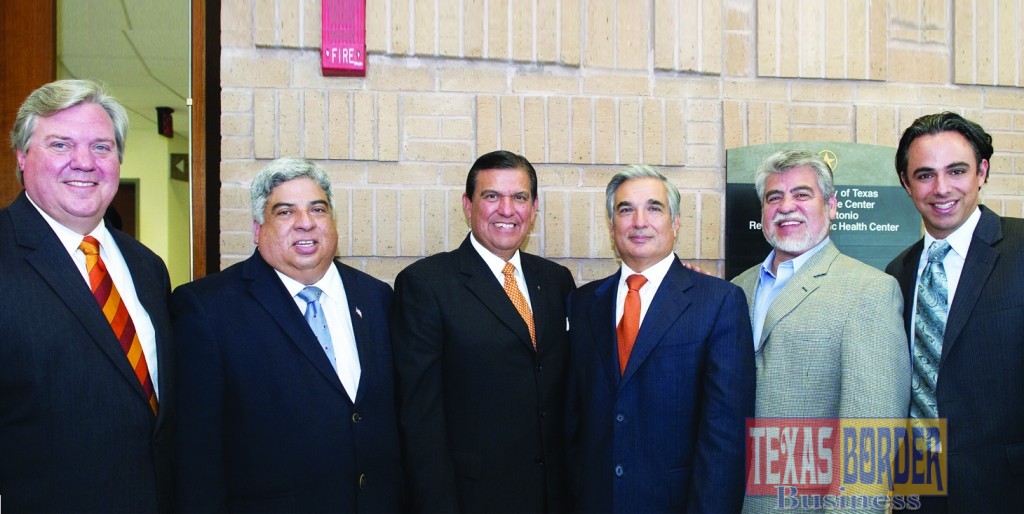
As originally published by Texas Border Business newsprint Edition on August 17, 2013
EDINBURG, TX – University of Texas System officials announced plans on Aug. 17 to significantly expand medical education in South Texas and graduate the first class of medical school students in the region in 2018.
UT System Chancellor Francisco G. Cigarroa, M.D., made the plans public at a news conference in Edinburg. In May, the UT System Board of Regents authorized future steps that will ultimately culminate in an independent, freestanding, comprehensive and research-intensive regional medical school in South Texas.
“On behalf of The University of Texas System Board of Regents, I am honored to make two announcements. First, the year 2018 will be a very special year for all of us. It will be the year that we graduate our first class of medical school students in South Texas,” UT System Chancellor Francisco G. Cigarroa, M.D. said. Second, we are beginning the transition of the UT Health Science Center – San Antonio Regional Academic Health Center—known as the RAHC – into an independent, freestanding, comprehensive and research intensive regional medical school, with its own president and structure, for South Texas,” Cigarroa said.
Cigarroa outlined a blueprint that he developed in coordination with UT System Chairman of the Board of Regents Gene Powell and Regent Robert Stillwell, Chairman of the Health Affairs Committee. The plan was developed to bring the new South Texas medical school to life, and it addresses a significant list of past commitments and future steps to move the project forward. Excerpts from the blueprint include the following:
The expansion of medical education and research initiatives will draw upon more than $79 million in infrastructure and other resources previously invested by the Texas Legislature and UT System in Cameron, Hidalgo, Starr and Willacy counties. The facilities include three buildings currently organized and operated under The University of Texas Health Science Center – San Antonio Regional Academic Health Center – a medical education building and an academic and clinical research building in Harlingen and a medical research building in Edinburg – along with a building in Brownsville for the school of public health under the University of Texas Health Science Center – Houston.
Within the past year the UT System Board of Regents invested an additional $30 million in South Texas to increase residency programs, support biomedical programs in obesity and diabetes, recruit exceptional faculty, build a clinical simulation facility, enhance the UTeach program to develop more graduates in math and science, and fund more science, technology, engineering and mathematics (STEM) programs.
Additionally, the Legislature contributes $10.8 million in recurring annual financial support through general revenue appropriations to support the medical and research divisions of the Regional Academic Health Campus.
An extraordinary number of other assets currently exist that support the enhancement of medical education and research, including nursing, physician assistant, and other health professional educational programs at UT Pan American, clinical rotations by 100 Health Science Center San Antonio students with more than 250 volunteer faculty, indications from hospitals in the region to support almost 100 additional medical residency programs, and more.
By 2018, the freestanding medical school will:
Increase the number of physicians and health professionals in South Texas
Expand residency slots
Expand and develop additional health science research and discoveries to improve health and attract research funding; and
Promote technology transfer and commercialization to enhance economic development
In his remarks, Cigarroa described how the UT System will utilize the strength and assets of UT Health Science Center-San Antonio (UTHSC-SA) in much the same way that in 1959 UTHSC-SA used the strength of UT Southwestern at Dallas and the University of Texas Medical Branch at Galveston to get its medical school off the ground.
Cigarroa predicted that the state would expect the same long-term success of the South Texas medical school as has been experienced by UTHSC-SA, as well as the contribution to the economic vitality of the Rio Grande Valley as has been experienced by San Antonio, Texas.
“As a native of South Texas, I know how important it is to increase the number of physicians and health care providers in a region of our state that has been historically underserved,” Chairman Powell said. “Nationally, more than 70 percent of physicians typically end up practicing medicine in the same region where they graduated. We must do everything possible to ensure we provide excellent medical education opportunities to our students in South Texas, and we must complement that with a commitment to improve the delivery and quality of health care,” added Powell.
“In 2010, I stated my commitment to plant a larger University of Texas System flag in South Texas,” Chairman of the Board of Regents’ Health Affairs Committee Robert L. Stillwell said. “I am extremely proud the UT System will marshal its considerable financial and human capital in the region to incentivize future collaborations among our health and academic institutions, bolster research and commercialization efforts, and spur regional economic development in the Rio Grande Valley by establishing a freestanding medical school,” Stillwell added.
In his remarks, Cigarroa also gave credit to the legislators who have worked so hard to provide the statutory foundation for the medical school, most recently in 2009 with passage of Senate Bill 98, authored by Senator Eddie Lucio, Jr., along with Senator Juan “Chuy” Hinojosa and Senator Judith Zaffirini, and sponsored in the House by Representative Eddie Lucio III, which authorized the creation of The University of Texas Health Science Center – South Texas.
Moving forward, the UT System will continue to work with local hospitals to increase the number of residency programs within Cameron, Hidalgo, Starr and Willacy counties. Additionally, System officials will work with state leadership – Governor Perry, Lt. Governor Dewhurst and Speaker Straus – along with the Texas Legislature and community organizations in these counties to increase funding and support for these programs and the new medical school.
Most importantly, the UT System will join together with a regional coalition of community leaders and stakeholders to work to successfully transition the Regional Academic Health Center into the free-standing, comprehensive, research intensive medical school the Rio Grande Valley deserves. “We are here now and for the long-term. Now is the time to realize this dream,” Cigarroa said in his closing. TBB













